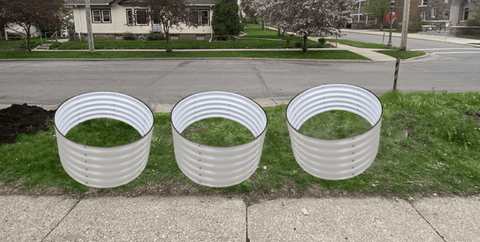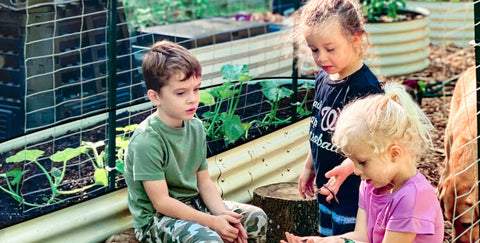Tips from Olle Garden Bed:How To Do Container Gardening
Container gardening can also be called pot gardening. It is plants that grow widely in containers, not on the ground. The container in gardening is usually a small closed portable object that you choose to display plants. The following content also has some reference value for raised garden beds.
It doesn't matter that most people prefer to use flowerpots. You can also use boxes, baskets, cans, buckets or baskets. Here are some things you should consider when practicing container gardening.
Select a container
Container gardening is very suitable for places with limited garden space; Therefore, the selection of containers will depend on several factors. Again, where you want to place the container is important. Let's take a look at some considerations in container selection.
Container size
Ideally, horticultural containers should be large enough to provide space for the spread of soil and roots. The type and number of plants you want to plant on the container will affect the size of the container.

For shallow rooted plants, you only need a smaller container. Those deep-rooted crops need more space and depth to get the best results.
Material type
There are many materials that are very suitable for gardening containers. Avoid using toxic materials to avoid accidental contamination. Each container has its advantages and disadvantages.
wood
Wood is easy to use. You can use it to create garden containers of various styles. If you want a more traditional look, this is a good choice. Use antiseptic wood and avoid pressure treated wood, otherwise arsenic may be immersed in the soil.
Metal
Metal containers look great. They can make perfect flower pots. In order to use, they need to be painted to remain attractive. They create a unique appearance in the garden, but they are easy to rust, and these metal containers will burn plants in severe heat.
plastic cement
There are many kinds of plastics, some of which are very attractive and high-end. Whether you are buying high-end containers or cheap ugly containers, plastic is always practical. The plastic pot is resistant to damage and cracks even if it falls. However, they become brittle with cold and age.
Textile

Fabric is an excellent material for making flower pots for planting plants. Plants like them! The best thing about them is that they are breathable. They are light in weight, so they are very durable, and you can wash them off after one season. Plants can thrive in these.
Good drainage
Drainage of potted plants is crucial and should not be ignored at all costs. Plants need air, water, warmth and proper lighting, which should be provided even during the life of boring containers.
The water supply to the plant should be sufficient. No matter what kind of container you choose, drain holes are essential, because without these holes, the soil will be submerged by water, and the plants may eventually die. You can choose self watering, double wall containers, or hanging baskets for plants that need frequent watering.
Determine the placement of plants
Container gardening is not always about which plants look great in a given container. The placement of containers can play an important role in how plants thrive. Here are some factors to consider when looking for the best location for containers. These containers should be placed where plants can thrive.
sunshine
Plants grown in containers require light that varies from plant to plant. Some plants may need more direct sunlight than others. One advantage of container plants is that they can be moved.

Plants can tell you when you don't get enough light, because the stems become thin and tend to light. If there is not enough lighting, light emitting lamps can be used. Always make sure the sun is about 6 inches above the plant.
temperature
Gardening plants require different temperatures. Some may need warm temperatures, while others prefer cool temperatures to thrive. It is important to understand the past of plants; It allows you to choose a perfect temperature to make plants feel at home. Ideally, some plants may require lower temperatures at night; So you need to know what works better.
water
Water is vital to plants because it helps them move nutrients effortlessly. Most plants like to water when the soil is dry. For plants planted in containers, always make sure to drill drain holes. The frequency of watering plants depends on the size of the plant, the time of the year, and the type of plant.
Find an ideal location where you think it might be easier to install a drip tube near the container. This drip line is helpful for automatic watering, more like drip irrigation.

wind
Container plants should be placed where the wind blows freely, as airflow is required. In this way, they get all the air circulation they need to grow. When planting indoors, it may not be necessary to open windows, as temperature fluctuations can cause breezes.
When possible, you can use the fan for container house plants. In addition, wind increases the evaporation rate of leaves. Evaporation plays an important role in the transport of nutrients needed by plants.
Use high-quality soil
The soil used in containers shall be balanced to retain moisture and facilitate adequate drainage. Unless you have well drained sandy loam or silty loam, your container soil should be much lighter. Ordinary garden soil may not drain well in the flowerpot, while clay may retain too much water for the root to grow.
For suitability, you can mix sand and organic matter to make the container mixture suitable for your plant. Keep in mind that the plants grown in containers depend entirely on your basic needs; Therefore, you should choose the best soil. The optimum soil for the container has the following characteristics:
It should be medium soil, so it should not be too light or too fluffy.
It should have good drainage and be able to retain moisture.
It should be porous to allow water and air to reach the roots of the plant.
The smell should be pleasant, moist, not soggy.
What plants can grow in container garden?

All kinds of plants can survive and thrive when they grow in containers. These plants may be flowers, herbs and vegetables.
flower
Flowers have different colors and shapes. They give your home an attractive and warm feeling. Many flowers perform well in the container and bring color splash to the balcony container garden. These flowers can be left to grow and look beautiful after being cut off. They include azalea, calla, cerosia, chamomile, chrysanthemum, narcissus and dahlia.
Herbs
Herbs grow naturally and are rated as one of the most valuable container plants. You can plant different herbs together, as long as you don't mix herbs that need a lot of water with those that like well drained soil.
Be sure to choose herbs of similar size, as one herb may overgrow the other. Herbs suitable for container planting include rosemary, thyme, chives, mint, turnip, coriander and laurel.
Vegetables
Most people usually grow vegetables in garden containers. You don't need a wide area to grow these vegetables. Some of the most natural plants include but are not limited to tomatoes, peppers, eggplants, potatoes and kale.
Simple plants start
If you are a beginner, you'd better know which plants are easy to grow in your limited space. Tomatoes are one of the plants that are easy to grow, and people have adopted their own planting methods. It depends on the size of your container and the variety you like to grow.

Herbs such as coriander and sage can thrive on a single container. As long as they have all the necessities and are in the right place for them to flourish, they don't need so much attention. Strawberries are also well made in containers, but you should make sure they have enough sunlight and are harvested regularly.
On the other hand, cucumber is planted vertically to obtain the best yield. It also doesn't need much attention, making it easy to grow. Leaf vegetables cannot be excluded from this list because most people have developed a culture of growing vegetables at home. These are one of the most natural plants you should try.
Adding Plants to a Container
After selecting the best container for your plant, you should prepare the same container and fill it with the correct soil. The higher the productivity of container soil, the better the growth of plants. After the container is filled with fertile soil, you can choose the appropriate vegetable food.
Plant foods should help to increase crop growth and reduce transplant losses. Later, you can follow these steps when migrating.
Choose a factory that suits your local conditions to avoid disappointment and ensure its rapid establishment.
Prepare the plants to add to the container. This is done by collecting any yellowish leaves.
Crop plants to promote lateral growth by cutting directly above leaf nodes.
Place the highest plant in the center of the pot and make sure that the soil is not compressed.
Fill the remaining space with soil to ensure that the plants are firmly stuffed in place.
Water the plants and let them drink a lovely long drink until the water flows out of the drain hole.
You can choose to fertilize the crops. Select fertilizer with high phosphorus content to promote plant growth.
You can now maintain plants to ensure higher yields.
Use the right tools
Basic tools for container gardening include hand trowels for mixing soil, digging holes, and helping seedlings transplant. Hand tillers help to cultivate container soil and mix slow release fertilizers.
Trimmers are used to cut wooden stems and twigs or harvest vegetables. Gardening gloves prevent your hands from getting muddy. Watering can be used to maintain the water needed by plants. Micro tip scissors are used to cut leaves and flowers.

Nursing tips to remember
You can prevent garden tools from rusting by storing them in the builder's sand.
Fungi are harmful to your garden. You can keep away from them by scattering cinnamon on the soil. In this way, it will not grow on your seedlings.
Don't throw away the toilet paper holder. You can reuse them as mini biodegradable planters.
If you have some tomatoes in your garden, you can sweeten them by sprinkling some baking soda on the soil.
Place the plastic fork upright in the soil to prevent animals from entering the garden.
Planting mosquito repellent herbs.
It is the perfect butterfly feeder to put overripe fruit on a ceramic plate in the shade.
Benefits of container gardening
If you don't believe in planting plants in containers yet, here are a few reasons that might change your mind.
Container gardens can be grown anywhere in your home. You can place them on a balcony, terrace, or courtyard. You have the opportunity to produce a variety of plants that may not be suitable for growing in your garden soil. Almost anyone can use the container, including those with limited mobility.
Small surfaces do not need to be weeded frequently because weeds are unlikely to enter the container. You can move the container to the place you want to meet the growing conditions of plants. In addition, you can rearrange the plants to suit your taste.
